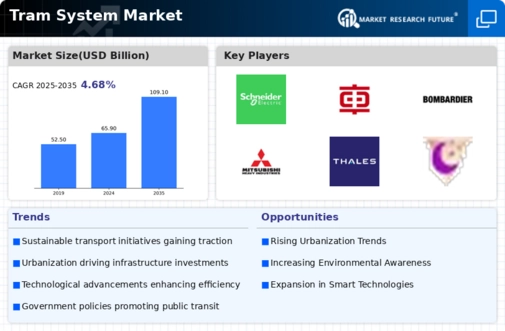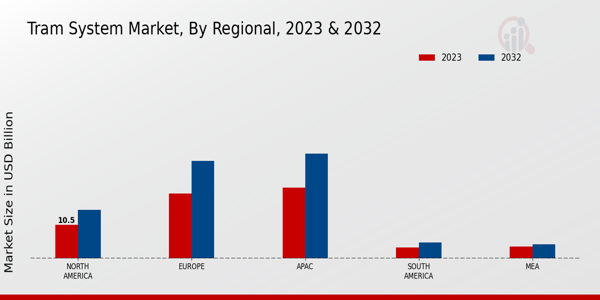Market Growth Projections
The Global Tram System Market Industry is poised for substantial growth, with projections indicating a market value of 65.9 USD Billion in 2024 and an anticipated increase to 109.1 USD Billion by 2035. This growth trajectory suggests a compound annual growth rate of 4.68 percent from 2025 to 2035. Factors contributing to this growth include urbanization, government investments, and technological advancements. The increasing focus on sustainable transport solutions further supports this upward trend, as cities worldwide recognize the importance of integrating tram systems into their public transport frameworks. This market growth reflects a broader commitment to enhancing urban mobility.
Technological Advancements
Technological advancements are significantly influencing the Global Tram System Market Industry, as innovations in tram design and operation enhance efficiency and passenger experience. The integration of smart technologies, such as real-time tracking and automated systems, is becoming increasingly common. These advancements not only improve operational efficiency but also attract more riders, thereby increasing ridership. Cities like Amsterdam are implementing smart tram systems, showcasing the potential for technology to transform public transport. As these technologies evolve, they are expected to contribute to the market's growth, aligning with the projected CAGR of 4.68 percent from 2025 to 2035.
Government Initiatives and Funding
Government initiatives play a pivotal role in the Global Tram System Market Industry, as many nations prioritize sustainable transport solutions. Various governments are allocating substantial funding for tram infrastructure projects, which is expected to drive market growth. For instance, countries like Germany and the Netherlands have committed to enhancing their tram networks, with investments projected to rise significantly. This trend is likely to contribute to a compound annual growth rate of 4.68 percent from 2025 to 2035. Such initiatives not only improve public transport but also stimulate local economies, creating jobs and fostering urban development.
Urbanization and Population Growth
The Global Tram System Market Industry is experiencing a notable surge due to rapid urbanization and population growth. As cities expand, the demand for efficient public transportation systems increases. In 2024, the market is valued at 65.9 USD Billion, reflecting the need for sustainable transport solutions. Urban areas are projected to house 68 percent of the global population by 2050, necessitating the expansion of tram networks. Cities like Paris and Melbourne are investing heavily in tram systems to alleviate congestion and reduce carbon emissions, indicating a global trend towards integrating trams into urban planning.
Public Demand for Efficient Transport
The Global Tram System Market Industry is driven by the growing public demand for efficient and reliable transport options. As urban populations swell, commuters seek alternatives to congested roadways. Trams offer a reliable solution, often providing faster transit times compared to buses and cars. Cities such as Toronto are expanding their tram services to meet this demand, reflecting a broader trend towards enhancing public transport. This increasing preference for trams is likely to bolster the market's growth, contributing to its projected value of 65.9 USD Billion in 2024 and further growth towards 109.1 USD Billion by 2035.
Environmental Concerns and Sustainability
Increasing environmental concerns are propelling the Global Tram System Market Industry towards more sustainable transport solutions. Trams are recognized for their lower carbon footprint compared to traditional vehicles, making them an attractive option for cities aiming to reduce greenhouse gas emissions. With global awareness of climate change rising, cities are investing in tram systems as part of their sustainability goals. For example, cities like San Francisco are expanding their tram networks to promote eco-friendly transport. This shift towards sustainability is likely to enhance the market's value, projected to reach 109.1 USD Billion by 2035.
























Leave a Comment